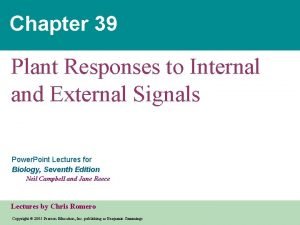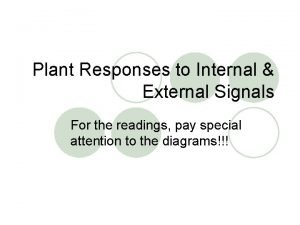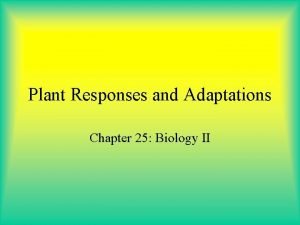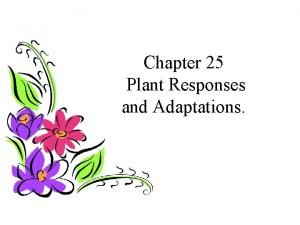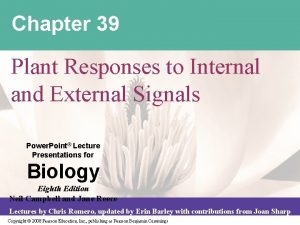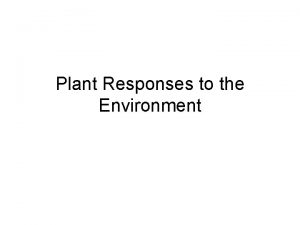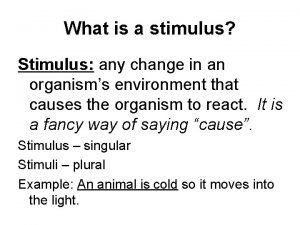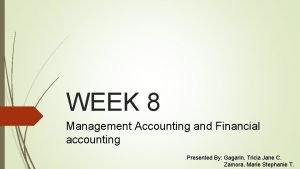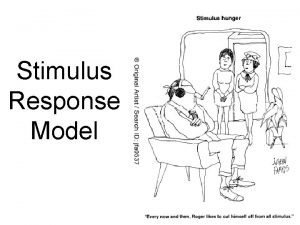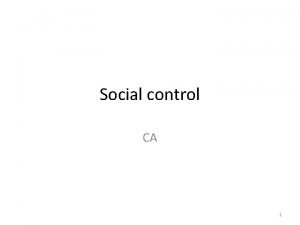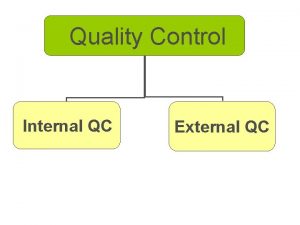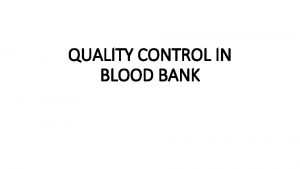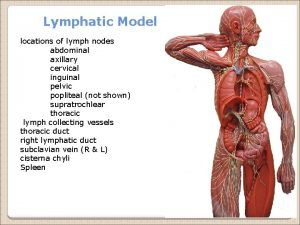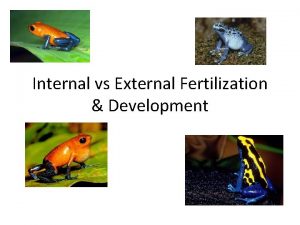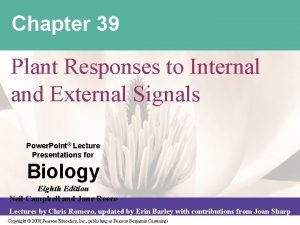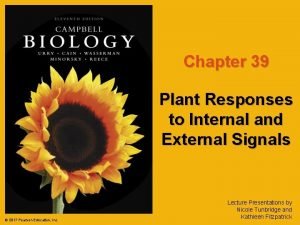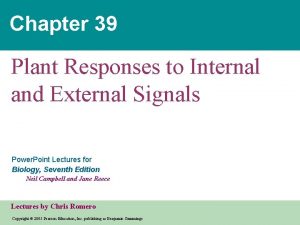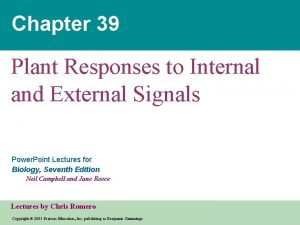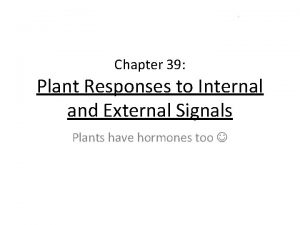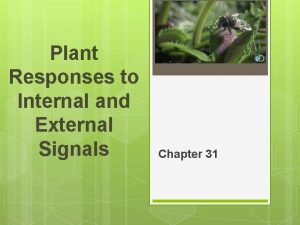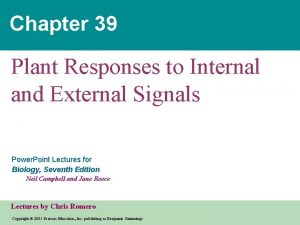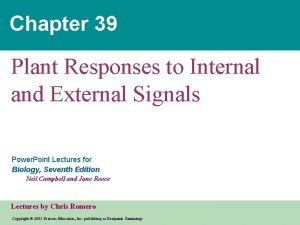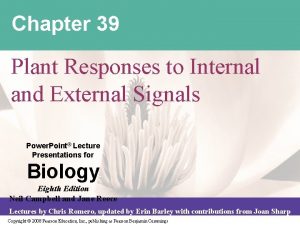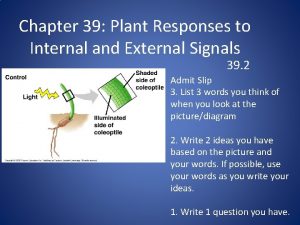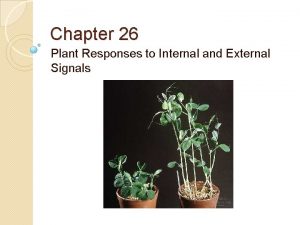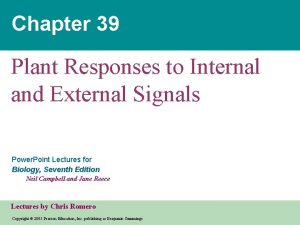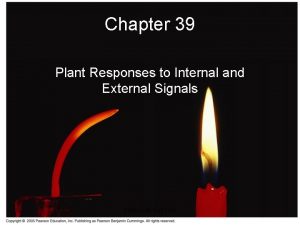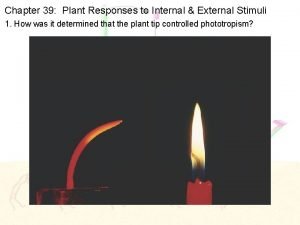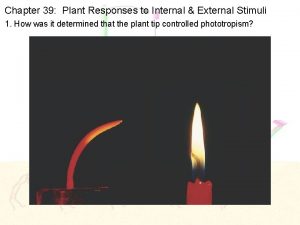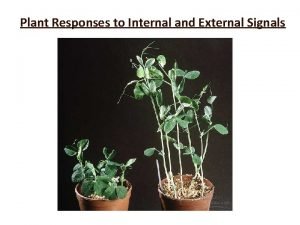Chapter 31 PLANT RESPONSES TO INTERNAL AND EXTERNAL
























- Slides: 24

Chapter 31 PLANT RESPONSES TO INTERNAL AND EXTERNAL SIGNALS

Plant Responses - Tropisms Phototropism Gravitropism Thigmotropism Apical Dominance (bud at end of stem inhibits growth of auxillary bud) • Abscission – Fruit and Leaf (shedding) • Parthenocarpy (production of fruit w/out fertilization) • Photoperiodism • •

Tropisms • Growth toward or away from a stimulus • Gravitropism (Gravity) • Phototropism (Light) • Thigmotropism (Touch)

Gravitropism

Gravitropism Plants response to gravity – geotropism Auxins (plant hormone) aka IAA Shoots show negative gravitropism (againsy gravity) Roots show positive gravitropism (with gravity) Statoliths – starch containing plastids detect gravity and causes Auxin to accumulate • Auxin concentrates on the “low” side of the stem bending it upward – Shoots respond to high concentrations of IAA • Auxin concentrates on the “low” side of the root bending it downward – Roots respond to low concentration of IAA • • •

Phototropism • Plants response to light • Auxin (horomone) • Auxin is produced in the apical meristem (end of shoot) of the shoot and travels down by active transport to the zone of elongation. • If equally produced then the stem will grow straight • Auxin will concentrate on a shady side of a stem • Therefore the plant stem will bend toward the light because there is greater elongation on the shady side.

Darwin and Darwin Phototropism (1880) tip responds to light Light Tip removed Tip Base covered Tip covered by opaque shield by transcap parent cap

Boysen-Jensen (1913) Phototropism, signal for bending light is actually a mobile chemical, see figure 39. 5 Light Tip separated by gelatin block Tip separated by mica

Thigmotropism

Thigmotropism • Plants response to touch • Not well understood • Vines will climb up walls or trees for support based on touch • Some plants respond to touch rapidly – Action potentials similar to nervous system

Etiolation (growth in darkness) • The stems of plants raised in the dark elongate much more rapidly than normal, a phenomenon called etiolation.

Review of Signal Transduction • Communication in Organisms – Cell to cell Recognition • Glycoproteins and glycolipids – Carbohydrates – Cell Junctions • Gap Junctions • Plasmodesta CELL WALL 1 Reception CYTOPLASM 2 Transduction – Short Distance • Local Regulation – Growth factors – Paracrine Signaling – Synaptic Signaling – Long Distance • Hormones Relay molecules Receptor Hormone or environmental stimulus Plasma membrane 3 Response Activation of cellular responses

Signal Transduction Pathway CYTOPLASM CELL WALL 1 Reception 2 Transduction Relay molecules Receptor Hormone or environmental stimulus Plasma membrane Figure 39. 3 3 Response Activation of cellular responses

De-etiolation (greening up) pathway • 1. Light signal detected by phytochrome receptor • 2. c. GMP stimulates a kinase which stimulates transcription factor 1 OR Ca 2+ stimulates transcription factor 2 3. Translation produces enzymes that cause the plant to green up!

Plant hormones help coordinate growth, development, and responses to stimuli • Hormones – Are chemical signals that coordinate the different parts of an organism

Fill out plant hormone chart

Auxin Tutorial • http: //bcs. whfreeman. com/thelifewire/conte nt/chp 38/3802003. html

Photoperiodism • Response of plants to changes in the photoperiod (relative lengths of day and night) • Plants detect the color, wavelength, direction, and intensity of light • Plants maintain a circadian rhythm – internal biological clock – Phytochromes – absorb red wavelengths of light – Pfr – far red – absorbs wavelengths 730 nm (inhibit) – Pr - red – absorbs wavelengths 660 nm (smaller wavelength stimulates)

Photoperiodism • Pfr – resets the circadian – rhythm clock • Pr – synthesized in plant leaves • Pr and Pfr are in equilibrium during daylight • Pr – accumulates at night • Pr Pfr at daybreak until equilibrium is reached • Length of the night determines the circadian rhythm Plants switch between isomers. Pr: absorbs red light, switches to Pfr, seed germinates & phytochrome can now absorb far red light for next process

Photoperiod: the relative lengths of night and day * Is the environmental stimulus plants use most often to detect the time of year, red light interrupts the photoperiod. Far red light does not. It’s the length of the dark that affects response, not day length.

Flowering Plant Groups • Long-day – flower in the spring and early summer when daylight is increasing • Short-day – flower in the late summer and early fall when daylight is decreasing • Day-neutral – do not flower in response to light – Respond to some other environmental cue • H 2 O or temperature • Floragin hormone triggers flowering of plant based on cue

Plant & Pathogen Tutorial • http: //bcs. whfreeman. com/thelifewire/conte nt/chp 40/40020. html

Genetic Control of Flowering • Flower formation involves a phase change from vegetative growth to reproductive growth • It is triggered by a combination of environmental cues and internal signals • Transition from vegetative growth to flowering is associated with the switchingon of floral meristem (permanant embryonic tissue) identity genes

ABC Flower Formation Model • Plant biologists have identified several organ identity genes that regulate the development of floral pattern • The ABC model of flower formation identifies • how floral organ identity genes direct the • formation of the four types of floral organs
 Seed germination
Seed germination Plant responses to internal and external signals
Plant responses to internal and external signals Chapter 25 plant responses and adaptations
Chapter 25 plant responses and adaptations Chapter 25 plant responses and adaptations
Chapter 25 plant responses and adaptations Respond to
Respond to Plant hormones and responses
Plant hormones and responses The stationary life
The stationary life Interactions between ais and internal and external parties
Interactions between ais and internal and external parties Chapter 10 stress responses and stress management
Chapter 10 stress responses and stress management Sepal function
Sepal function Any change in the environment
Any change in the environment Internal users of accounting information
Internal users of accounting information Difference between internal and external stakeholders
Difference between internal and external stakeholders Stimulus respons modellen
Stimulus respons modellen Pepinsky social control
Pepinsky social control Internal and external factors of nationalism
Internal and external factors of nationalism Reliability test in research
Reliability test in research Internal and external qc
Internal and external qc Internal and external quality control in blood bank
Internal and external quality control in blood bank Stakeholder internal and external
Stakeholder internal and external Abdominal nodes location
Abdominal nodes location Objective of quality
Objective of quality Interrupts in 8051
Interrupts in 8051 Birds
Birds Computer external components
Computer external components
